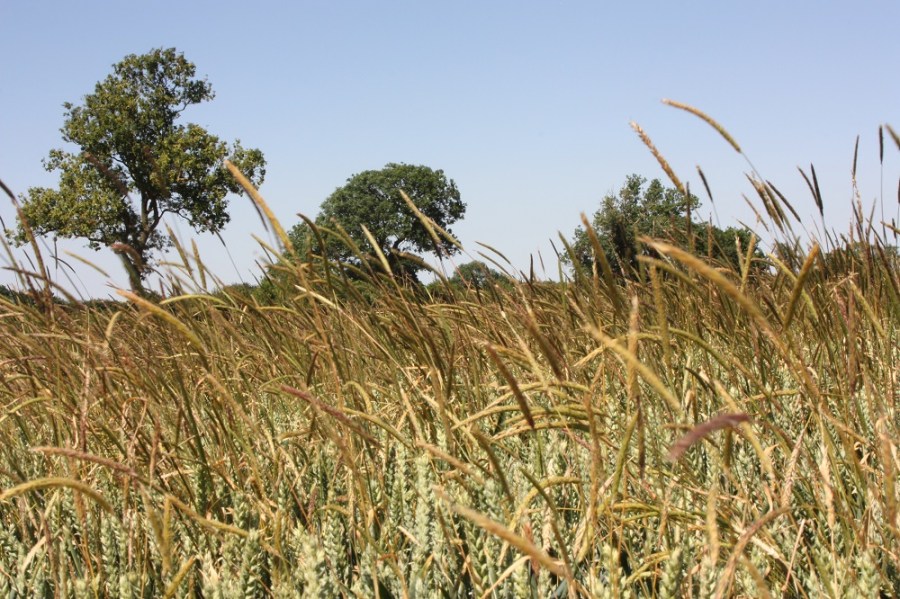Spring cropping is one of the main cultural controls for blackgrass but the million-dollar question is how long for? The rotational trials at Project Lamport indicate it may be longer than you think. CPM reports.
On this site it was too soon to return to winter cropping after just two spring wheats.
By Lucy de la Pasture
Cultural methods are now well established as playing an important part in any strategy to control blackgrass. But how to put together the many pieces of the puzzle to achieve the best possible control isn’t always clear. And that’s where the long-term Agrovista trial at Lamport in Northants is proving illuminating.

Mark Hemmant says any effect on soil health of the different rotational systems is going to be assessed in future years.
Project Lamport is coming to the end of its fifth season, originally intended to be its last. With the results from the trial highlighting there are still many lessons to learn, the work has been extended for the foreseeable future. A decision encouraged by an increased interest in soil health which, along with a changing political landscape and a ‘Green Brexit’ on the horizon, means the work at Lamport has never been more relevant to the problems growers may increasingly face, believes Mark Hemmant, Agrovista’s technical manager.
The site has been running 14 different rotational trials over the past five years and these are now beginning to yield some interesting results, with the ‘right’ and ‘wrong’ rotational decisions plainly obvious to see. There have been disasters in terms of blackgrass control, as well as crop failures where different spring crops have been experimented with. But there are also some very clear trends becoming apparent, particularly regarding cover crops and the number of years a spring crop is needed to keep blackgrass populations from exploding again.
Mark says one of the things that has become obvious at Lamport is that less steel and more roots has really benefitted soil health. “Where we’ve used cover crops in the rotational strips you may not see a difference, but you can certainly feel it when you walk over the strips. The ground is noticeably tighter where cover crops haven’t been grown.
“It’s one of the reasons we recommend using black oats in the cover crop mix because they root more deeply than tame oats,” he says. “Improving soil health also means less blackgrass because crops are better able to compete with the weed, helping keep numbers lower than where the soil is compacted.”
At Lamport the most successful of the rotational systems are all using spring crops after a cover crop. Over the years a blueprint has been developed to get the best results in terms of yield and blackgrass control.
“The cover crop mix needs to allow the blackgrass and other weeds to germinate to effectively reduce the seed in the seed-bank and any potential competition in the spring crop. Black oats and vetch have proved ideal to get this ‘flushing’ effect and because it has a low C:N ratio, the mix doesn’t rob nitrogen from the following crop,” explains Mark.
“Every year at Lamport, including an autumn cover crop in the rotation has worked, regardless of the season’s weather conditions. We use a stale seedbed, with a shallow pass with the X-press cultivator and drill the cover crop in early Sept to get good establishment.”
Direct-drilling the cover crop has been attempted at Lamport but resulted in a failed crop, mainly due to poor trash management on the surface, notes Mark. The most successful establishment method has been a culti-drill, which also promotes a flush of blackgrass, and this autumn it will be used after the stubble has been raked.
“We’re looking at using less cultivations but we’re not quite there yet with the cover crop,” he admits. “By Christmas the cover crop will be gone because we’ve found the spring crop grows better, yields are higher and there’s less blackgrass if the cover crop is removed early. Where blackgrass is a consideration, this is crucial so that the blackgrass doesn’t get too big when the cover crop is destroyed. If it does then shading becomes a problem, resulting in poor blackgrass control, which isn’t a good glyphosate resistance management strategy either.”
The system that has proved most consistent in terms of yield and blackgrass control is a cover crop followed by spring wheat. Five years on, blackgrass numbers are consistently at around 2 heads/m2 under this regime. One of the systems trialled adopted this approach for the first two seasons and then received a deep cultivation before returning to winter wheat in year three – an approach many farms are taking as they introduce spring cropping into the rotation but want to return to winter cropping as soon as possible.
“It showed us that on this site it was too soon to return to winter cropping after just two spring wheats. The blackgrass population in the winter wheat increased to 129 heads/m2 (from 13 heads/m2 the previous year), but the real problems occurred in the following crop,” says Mark.
In an effort to get back on top of the blackgrass the decision to return to a cover crop followed by spring barley was made, following the rule of thumb that when blackgrass populations reach 40 heads/m2 it’s the trigger for a drastic change in management, such as a switch to spring cropping.
“In the autumn there was so much blackgrass that it almost out-competed the cover crop. When it was sprayed off in late winter, there was a wet mulch of dying blackgrass which then dried up to form a crust. We sprayed a second glyphosate pre-drilling in the spring but surviving blackgrass was protected by this crust and grew. There was so much blackgrass in the spring barley that we made the decision to destroy the crop to limit seed return.
“The following autumn there was still a lot of blackgrass in the cover crop, but it was destroyed at the end of Nov. The spring wheat currently in the ground was drilled mid-April and looks great, with very little blackgrass to be seen,” he notes.
Another of the valuable lessons learned at Lamport is the importance of maintaining the seed rate when drilling spring crops. The reasons are two-fold, explains Mark.
“In the spring, the percentage establishment achieved can be low and we need a good plant population to compete with any blackgrass that may germinate within the crop. We’ve used 550 seeds/m2 for spring wheat and the seed rate comparisons in the min-till plots mean we will probably plant 600 seeds/m2 in 2019. The first concern of growers is always that it’s an increased seed cost, but our view is that the increases in yield possible, due to less blackgrass competition, more than compensates for the up-front expense.”
For spring barley, Mark recommends 450 seeds/m2 of KWS Irina and doesn’t believe there’s much room to go any higher without having a negative effect on barley quality through increased screenings. Spring oats are also being looked at this season and the crop of Elyann at 400 seeds/m2 looks full of promise, says Mark.
In a blackgrass situation, spring oats may not seem the ideal crop to help control a tricky grassweed with limited herbicide options, but Mark’s not fazed by this problem. The spring oats were direct-drilled in mid-April and received 50g/ha DFF as a pre-emergence herbicide, which with excellent competition from the crop appears to have done a good job.
“We planted a black oat and phacelia cover crop in the autumn before the spring oats to flush out the blackgrass. It’s important to be aware of the potential pitfalls using this mix because phacelia can set seed in a mild autumn, so it may need to be topped off to prevent.”
Other large-scale plots at Lamport continue to investigate different tillage systems, with winter and spring crops established under various cover crop and cultivation regimes. For the first time since the trial began, rotational ploughing has been introduced on a large scale, with half the plots being turned over last autumn to mimic what’s likely to be common practice on many farms. The remaining plots were established using ongoing min-till regime.
“Where we ploughed and there was no cover crop, there was soil erosion over the winter which has made the blackgrass worse. In general though, there appears to be less blackgrass after the plough compared with the min-till, though the crops look very similar at the moment.
“If the dry weather continues, I’d expect to see wheelings begin to show up in the crop where the ground was ploughed because the soil is fluffier and the drill was heavier,” says Mark.
The success of blackgrass control and crop establishment using two different minimal disturbance/zero-till drills – the Weaving and Sky EasyDrill after cover crops or fallow is also being compared at Lamport.
“Interestingly it wasn’t the same drill that came out on top last autumn as in the previous year, which shows that the best tool for the job is likely to vary with seasonal differences each year,” he comments.




